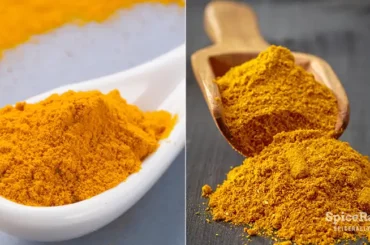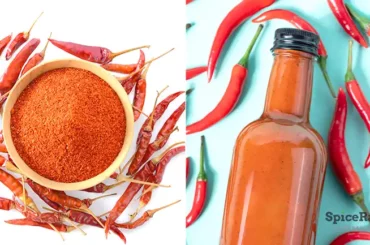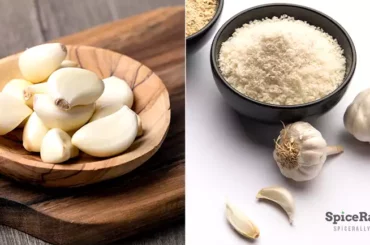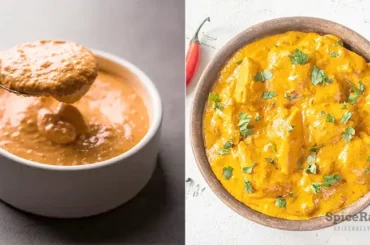Sambar powder and curry powder are nothing new to Indian households. But there are times when we all need clarification when using these two blends. So, let’s learn everything about sambar powder vs curry powder.
Curry powder usually has many variations, countering depending on the region, household, or production. On the other hand, sambar powder encloses a similar set of ingredients without many variations. Also, curry powder has a more versatile flavor profile than sambar powder and pairs with a wide range of dishes. But sambar powder mostly complements vegetables and lentils.
So, let’s dive right into the difference between these Indian staples and see how they compare!
Sambar Powder vs Curry Powder- SpiceRally DrillDown!
| Sambar Powder | Curry Powder | |
|---|---|---|
| Base flavor | Warm and spicy | Warm and spicy |
| Key ingredients | Chana dal Urad dal Toor dal Coriander Cumin Black peppercorns Mustard seeds Red chiles Turmeric powder Fenugreek seeds Curry leaves It might also include the following: Coconut Asafoetida Salt (occasional) | Turmeric Cumin seeds Black pepper Coriander seeds Fenugreek Garlic Ginger Cloves Red chilies (paprika/ cayenne pepper, Kashmiri red chilies) Cinnamon Mustard seeds *Other ingredients largely depend on the variation and may include the following: Allspice Bay leaves Nutmeg Curry leaves Fennel seeds Cardamoms |
| Flavor Profile | Could have a richer taste than curry powder due to the inclusion of ground lentils. But it can be less spicy and intense than curry powder with warm and earthy elements. | It could be less rich than sambar powder due to the absence of ground lentils. But curry powder could still impart bolder, deeper, more spicy, and more potent flavor notes than that of sambar powder with warm and earthy edges. |
| Heat and spiciness | Mildly spicy and less hot when compared to curry powder | Generally more spicy and hot when compared to sambar powder. But these factors might vary depending on the variety of curry powder. |
| Texture | Can be somewhat coarser than curry powder. | Finely powdered and has a more refined texture than sambar powder. |
| Color | Generally has a yellowish, brownish tone. | The color of curry powder usually depends on the ingredients used. However, it can have a variety of colors ranging from yellow and brown to deep chocolate brown. |
| Mode of usage in cooking | As an ingredient | As an ingredient |
Click here and go to this article to learn more about the flavorful sambar powder.
| Usage in cooking | – Mainly used in making sambar curry – Can be included in other vegetable and lentil curries – Jazzes up rice dishes – Flavors liquid-based dishes like broths, soups, and stews – Can be used as an ingredient in rubs and marinades for meat and fish | – Primarily used in making different types of curries – Can be incorporated into rice, pasta, and noodle dishes – Enhances the flavor of eggs, meat, fish and seafood recipes – Perks up chutneys and salads – Adds depth to fillings made for savory baked and fried goods |
| Variations | Variations do not exist | – Curry powder used in western cuisine – Indian/ Madras curry powder – Vindaloo curry powder – Thai curry powder – Sri Lankan roasted and unroasted curry powder – Japanese curry powder – African curry powder – Jamaican curry powder – Nigerian curry powder |
| Origin | Indian cuisine | Generally comes from Asian cuisine. But the curry powder used in Western cuisine is an Indian-inspired British creation. |
| Availability | Available in different Indian brand names and can be bought from supermarkets, Asian grocery stores, and online shopping sites. | – Widely available under many brand names, representing different countries. – Curry powder can be easily bought from any grocery store, Asian groceries, supermarkets, and online shopping sites. |
| Storage | Most store-bought sambar powder options can be kept outside with the rest of your dry spices or seasoning in a well-fitting glass jar. But it is advisable to keep coconut-included homemade sambar powder in the fridge to have a longer shelf life. | Refrigeration is not required. Any type of curry powder can be kept with the rest of your dry spices or seasonings when stored in an air-tight container in your spice rack or pantry. |
| Mode of production | Commercial and homemade varieties exist. | Commercial and homemade varieties exist. |
| Culinary ingredient category | Spice blend | Spice blend |
Let’s Get More Deeper Into The Difference Between Sambar Powder And Curry Powder!
One could not literally capture the difference between sambar powder and curry powder at a glance because they look very similar. But, as you see, these two spice blends are way different from one another, starting from their ingredients to flavor, usage, and versatility.
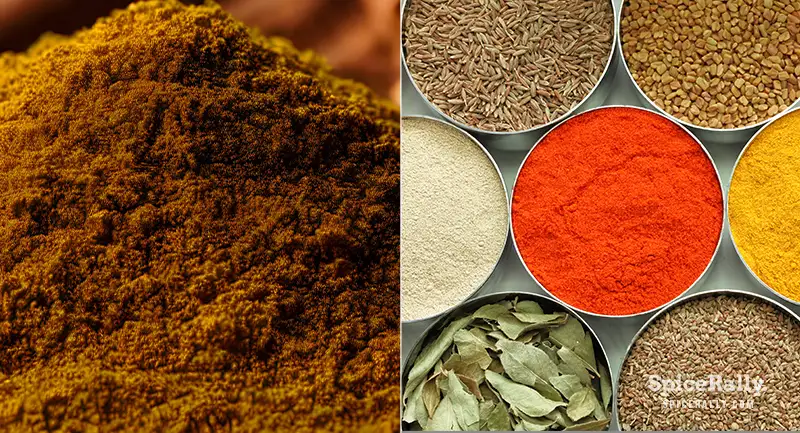
Curry powder has a more universal effect since you’ll be able to find many variations of it. And each variation possesses its unique characteristic flavor and features inherent to each cuisine. While on the contrary, sambar powder roots only from Indian cuisine and confines a similar group of ingredients, standing out from the rest of the traditional Indian spice blends.
Sambar powder is specifically used as the base when making India’s traditional dish, sambar curry. It also has a limited amount of uses when compared to curry powder. Curry powder is more versatile and flavorful and features more ingredients than sambar, offering a complex flavor to go with a wide range of recipes.
Similar Reads…
Can Sambar Powder Be Used In Place Of Curry Powder And Vice Versa?
Using sambar powder in place of curry powder is tricky since you should first know what kind of curry powder you’ll be substituting. As aforementioned, curry powder coming down from different cuisines has its characteristic flavors.
Therefore, sambar powder will not sometimes compare with their flavor profiles since some curry powder variations are way more intense than sambar powder. Accordingly, sambar powder can occasionally be used in place of Indian or Madras curry powder and the curry powder type used in Western cuisine.
However, you can use most curry powder types in place of sambar powder but ensure that sambar powder is only a secondary element in the particular dish. That being said, replacing sambar powder with curry powder in major dishes like the sambar curry will not give you a similar effect.

